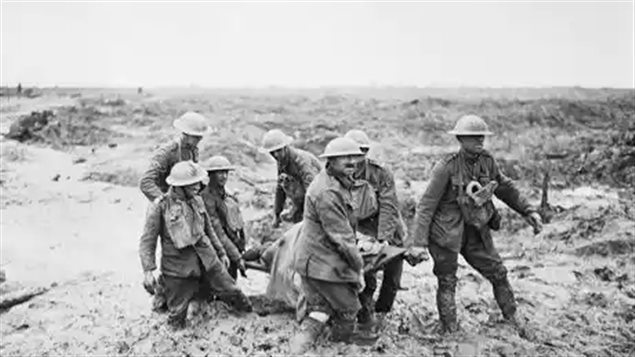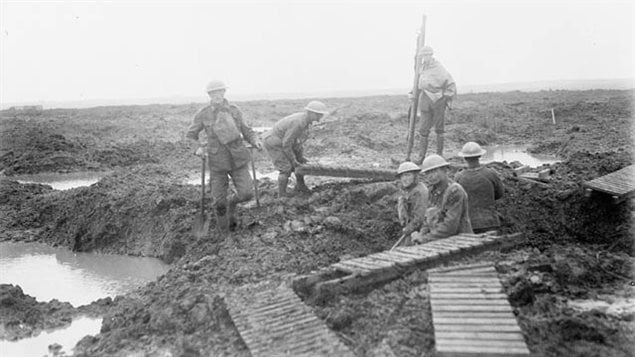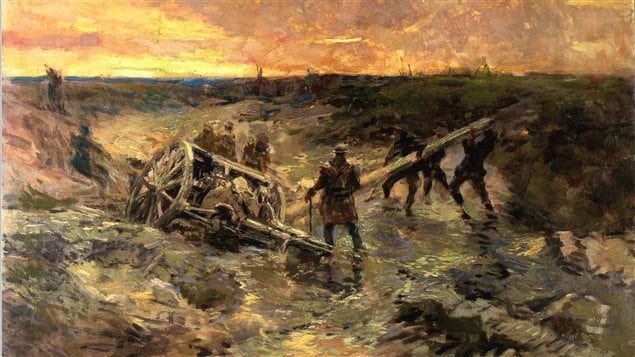The word “hell” doesn’t begin to describe it, but that was the only word that came close to describing the Third Battle of Ypres also known as the Battle of Passchendaele and used by survivors.
After British, Australian and New Zealand forces had been thrown into the battle at astronomical cost with little gain, British Commander Sir Douglas Haig, desperate to save his job in the face of horrific losses, called in the Canadians.
One hundred years ago, the Canadians succeeded in capturing the slight Passchendaele ridge, and the piles of rubble that had been the town.
Tim Cook, is an historian-Canadian War Museum, author and military/historical commentator
Listen
British Commander Sir Douglas Haig began the battle in July in an effort to weaken the Germans and free the Belgian ports which would simplify the Allied supply lines.
After the enormous Canadian-led success at Vimy in April, he had earlier requested the Canadians create a major diversion to the south to draw off German reserves as he battled in Flanders.
In August, in an entirely Canadian operation, the strategic high ground of Hill 70 overlooking Lens, France was captured in an amazing success.
Now the Canadians were ordered to Belgium to relieve the British effort and capture Passchendaele.
Canadian General Sir Arthur Currie, always mindful of not wasting the lives of his troops surveyed the battleground and declared it almost impossible and even unnecessary . “Leave the mud to the Germans” he said.

He also said, the Canadians could do but it, but it would result in about 16000 casualties.
– Private John Pritchard Sudbury
Wounded at Passchendaele 26 October 1917
The drainage systems for the low-lying ground had been blown up by the millions of shells, and the rains had never really let up turning the vast area into a quagmire. Canadians had to slog their way through the gumbo across open ground while Germans in hardened concrete bunkers sprayed them with machine guns and shells.

Entire guns would simply sink into mud, as did soldiers and horses both living and dead, while many would drown if they fell into the water filled shell holes.
The battle is estimated to have cost somewhere in the neighbourhood of 270,000 Allied lives, and slightly fewer German lives; at least half a million lives, all for a few kilometres of ground.
And, Currie would prove prophetic on all points. Canadians succeeded in taking Passchendaele, but at the cost of almost 16,000 dead, wounded, and missing
For the Canadians, Passchendaele signifies another victory, 100 years ago this week, under horrific conditions and against all odds. Nine of the highest honour in the Empire, the Victoria Cross, were awarded to Canadians in this battle.
For everyone else, it represents a useless bloodbath and waste of young lives due to the insensitivity and incompetence of the British Commander who came to be known as “Butcher Haig”. Currie was also prophetic about the battle not being necessary. The hundreds of thousands dead, all for a patch of ground that did not achieve the objectives hoped for, was reoccupied by the Germans the following spring after the Canadians were assigned elsewhere.
Royal Canadian Legion- YouTube
Additional information
- Veterans Affairs Canada: Passchendaele
- Tim Cook- author of several military history books
- CTV: 2008: Passchendaele (feature film) review
- Canadian Forces- Passchendaele
- PostMedia: C Sweeney: Nov 9/17: horror-heroics







For reasons beyond our control, and for an undetermined period of time, our comment section is now closed. However, our social networks remain open to your contributions.